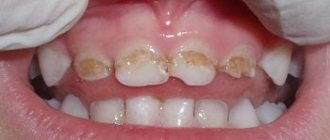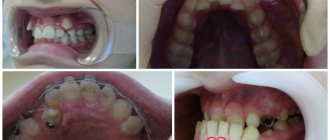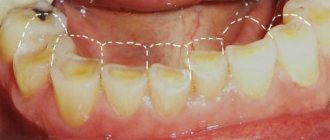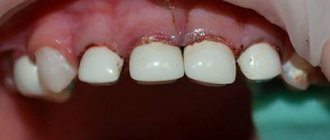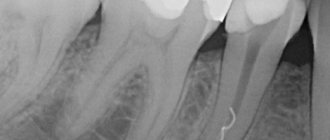Filling is a complex of dental procedures, including the removal of tooth tissue destroyed by caries, disinfection and treatment of the resulting cavity with adhesive preparations, placement and grinding of a dental filling.
Normally, after performing the above procedures, the patient should not experience discomfort or pain. For this reason, the appearance of any unpleasant sensations in the area of a filled tooth is an absolute reason for a return visit to the dental office.
How is a light seal different from a regular one?
In fact, the term “light filling” is more popular among the people, but experts usually use other names: photopolymer, light-curing, heliopolymer are the most common of them. A light filling is a fairly plastic material, and thanks to ultraviolet light it is much easier for a specialist to carry out a filling. This is the main difference between a light filling and a regular one. In addition, you can choose many colors and shades for a light filling, which is why it is so often used in the treatment and restoration of teeth in the smile area. In short, the main advantages of a light filling are reliability, durability and high aesthetics. These qualities make light-based dental fillings one of the most sought after in the dental market.
How to determine whether a filling is installed correctly
High-quality installation of fillings meets these criteria.
1. The anatomical surface of the tooth has been restored
That is, a special shape with tubercles and depressions (fissures), thanks to which the teeth perform the main function of grinding and crushing food. And they keep the jaws in the correct position so that the story you just read does not repeat itself.
1. Poor quality filling 2. Correct filling
At the DentaBravo clinic, after treatment, we show the patient the installed filling in a mirror and advise him to listen to his own feelings. You should not feel discomfort when you close your teeth.
2. A point contact point has been formed
Normally, adjacent teeth touch tightly at one point. Therefore, after installing a filling on the side surface of a tooth, there should be no gaps left between adjacent teeth where food debris can accumulate, causing the development of caries below the filling.
And our dentists know for sure that the filling material should not completely fill the space between the teeth, connecting two teeth.
Firstly, then the load on the teeth during chewing is distributed unevenly, and secondly, the filling itself will collapse faster.
If your gums become inflamed and bleed at the place where the filling is placed, and your teeth hurt when chewing, most likely the reason is a poor contact point.
3. The filling material does not hang over the edges of the tooth
If the filling does not exactly follow the contour of the tooth, but protrudes beyond its limits and has uneven edges, then food can again get stuck under it. And this, as you remember, is a direct path to caries.
4. The surface of the filling does not have microvoids or cracks
After installation, the filling is treated with burs and then polished to a perfectly smooth surface. At the same time, microscopic cracks and voids that are invisible to the eye may remain on the surface of the filling.
To get rid of them, we apply a special composite material to the surface of the filling, thanks to which the strength and color of the filling are preserved.
At the DentaBravo clinic, after filling, the doctor will definitely tell you how to care for your teeth in order to preserve the enamel and extend the life of the filling.
A filling made from high-quality material, made using technology, will last from 5-8 to 20 years (!), without causing you any inconvenience. And if the work was done by a dentist without sufficient experience and qualifications, then using even the most expensive material will not fix anything.
Therefore, when going for dental treatment, focus not only on the quality of the material, but also on the professionalism and experience of the doctor - and our advice will help you with this.
If you have already found a dentist you trust, we are very happy! And if not, come to our clinic, where the quality of treatment is guaranteed by specialists with 10 years of experience.
Composition of the light seal
The vast majority of filling types are based on the use of a mixture of several materials. A filling made from a light-curing composite has a rather complex composition, which is partly why it costs more than its analogues.
Light seal materials
- Heliocomposite.
The basis of a light filling, which under the influence of an ultraviolet lamp breaks down into radicals, due to which polymerization (hardening) of the filling material occurs. - Filler.
This can be silicon dioxide, glass ceramics, etc. The structure, color and area of application of the filling depend on the type of filler. - Connecting elements.
Place a filling in Minsk
When filling two teeth at once, a competent doctor must put 2 fillings, because installing one large filling on 2 teeth is not professional, not comfortable for the patient and not safe. To dental treatment under anesthesia from ending in repeated fillings and a double waste of time and money, seek help from reliable, experienced specialists. Well, if you add comfortable conditions and a complete absence of fear and pain to quality, then you should come to the Medexpert Center for Family Dentistry. Basic procedures in the clinic are performed only with the use of drug sedation. It allows patients to fall asleep, while increasing the pain threshold and maintaining all the vital functions of the body in a natural state. Sedation is not just dental treatment in your sleep , it is safe and painless. Dentistry has never been so comfortable for the patient.
Types of light seals
Some sources indicate that only anterior teeth can be restored using light-curing composite fillings, but this is incorrect information. Today, such filling is successfully used in all departments, except for the most inaccessible places (for example, “wisdom teeth”). All types of light fillings differ in the composition of the filler, which determines their characteristics.
| Light fillings for teeth | Description | Application area |
| Macro-filled light fillings (light fillings for chewing teeth) | The filler consists of solid large particles (macrophiles). They give the filling strength, but have a rough surface and tend to lose color. | Macrophilic light fillings are usually used on posterior teeth or on the inside of the dentition, where aesthetics are less important. |
| Microfilled light fillings (light fillings for front teeth) | Fillers consisting of small particles. They hold color well, can be polished, but are very fragile. | Mostly used in the smile area. |
| Nanohybrid | They consist of ultra-fine particles that are both durable and aesthetic. | Universal light fillings that can be used in all types of restorations. |
Types of fillings (difference from each other)
Any installed seal must meet many requirements, first of all, safety for humans, invisibility, durability and strength.
Color and properties depend on the material from which it is made. Often these are ceramics, plastic, amalgam, or special cements.
The first group is silicate and silicophosphate cements (“Sicilin”, “Fritex”). Used in dentistry for a long time.
The disadvantages are: not aesthetically pleasing, the ability to hold on only if the entire carious cavity is ideal.
They also cannot be polished, are rough and cause an unpleasant acidic taste in the mouth. Nevertheless, they are characterized by low toxicity and are often used in pediatric dentistry.
The second group is plastic fillings (for example, Acrylic Oxide). They are well known among senior dentists. And young specialists rarely know how to use this material.
The disadvantages of such fillings are the laboriousness of the treatment process and serious shrinkage during hardening. Over time, plastic fillings darken and wear off quite quickly. There is also a plastic smell in the mouth.
The third group is amalgam. It is an alloy of mercury and metal. The main positive feature is durability.
The main disadvantage is the metallic color of the filling, which over time stains the tooth. Popular in dentistry on the Asian continent.
The fourth group is composite. The advantage is low cost. The material is not very aesthetic, but is good for treating back teeth. Prices are quite different, depending on the country of production.
The fifth group is light-curing fillings. Microphiles are used to fill front teeth, and macrophiles are used for back teeth. There are also hybrids that can be used for any purpose.
This is the most modern material. Characterized by strength, aesthetics and durability. A blue-emitting device is used for hardening. Light filling is ideal for aesthetic restorative procedures.
The sixth group is glass ionomer cements. There are self- and light-hardening types. The advantages are the presence of fluoride in the composition, which reduces the risk of caries, as well as binding to the tooth, preventing the appearance of microcracks.
The disadvantages are the low level of strength and lack of aesthetics.
Installation of a light seal
Today, a light filling can be installed in almost any clinic. Installation has approximately the same number of steps as in the case of other types of fillings (with the exception of scanning with an ultraviolet lamp).
- Initial consultation, panoramic x-ray.
- Anesthesia.
- Preparation of damaged tooth tissues. During depulpation, the canals are treated and a temporary filling is installed.
- Placing a light filling (filling the area with filling material and giving it a primary shape).
- Polymerization of the filling under the influence of ultraviolet light.
- Grinding and finishing of the filling to achieve optimal shape and correct occlusal contact.
If after filling with a light filling your tooth hurts for more than three days or you feel discomfort when closing your jaws, contact your doctor as soon as possible. Find a trusted clinic where you can get a filling in Moscow on Startsmile.ru in the “Search for dentists” section
Silicate, silicophosphate cements
Materials from this group have been used by dentists for a very long time.
Silicone cements have a bright white color, do not hold well, are rough to the touch even after polishing, and when placing such a filling you will feel a sour taste in your mouth. But! “Sourness” also happens when installing an expensive filling, if the doctor used silicate cement for laying under the filling. Pros: such fillings are low-toxic, which is very good if you are treating a child’s teeth; low price (in some clinics they fill with silicate cement for free!).
Please note: the filling material of this group is prepared by mixing powder and liquid.
How much does it cost to install a light seal?
In order to most accurately tell you how much it costs to get a light filling, you need to understand what type of filling will be installed, as well as where exactly the treatment will take place. The cost of a light filling in a state clinic starts from 900 rubles. As a rule, this is a medium quality composite material intended for the restoration of chewing teeth. In private dental clinics in Moscow, the price of a light filling starts from 1,500 – 2,000 rubles. Light fillings for front teeth are more expensive: for aesthetic restorations, the price can exceed 3,000 rubles.
Do I need to take care of dental fillings?
After treatment of caries, the tooth loses its integrity, as softened diseased tissues are removed along with some healthy tissues that are located too close to the source of inflammation. To restore the integrity of the tooth, its chewing and aesthetic functions are filled with teeth. Currently, different materials are used for filling teeth: amalgam (silver), glass ionomer and composite.
All types of fillings shrink as they harden, that is, they lose part of their original volume. For this reason, microspaces are formed between the tooth and the filling material, where food debris, bacteria and saliva will penetrate, which leads to the development of repeated caries under the filling. Therefore, dentists especially strongly recommend that people with filled teeth undergo medical examinations once every six months for the timely detection of filling defects.
Filling manufacturers, as well as dentists, are constantly working to reduce the shrinkage of materials through careful tooth preparation and layer-by-layer application of the composite. However, at the moment, a composite filling lasts 3-5 years, and then it will have to be changed. If you do this in a timely manner, without waiting for the filling to chip or fall out, the process will take place with the least discomfort for you and will not harm the tooth.
But even a very good filling needs care and attention. Contact your dentist if you notice:
1. The filling has become dull and rough. A rough surface becomes more contaminated and it is more difficult to remove plaque from it. As a result, such a filling becomes a source of spread of pathogenic bacteria in the oral cavity.
2. It changed color and became darker. This usually occurs due to coloring by food products: coffee, strong tea, wine, chocolate, beets, etc.
3. Light or dark brown pigmentation has appeared at the border of the filling and the tooth - a visual sign of caries under the filling. With such a filling, you need to immediately contact your dentist, because if the pulp has not been removed, the tooth will soon ache, but it will no longer be caries, but pulpitis. Even if the tooth does not hurt, tooth decay has already begun, which can lead to its loss.
4. The difference between the filling and the tooth became visible, which does not look very nice.
And also, if the filling is 5 years old or more, the dentist will examine the fillings, identify their defects and suggest ways to eliminate them. In some cases, it is too early to replace the filling and it will be enough to polish it.
By the way, during preventive examinations at Family Dentistry, polishing of fillings is carried out free of charge as part of the professional hygiene complex.
In our clinic we use the most beautiful fillings - composite ones, which give excellent aesthetic results and a low percentage of shrinkage, about 1%. Using the method of layer-by-layer application and illumination with a lamp allows you to create a very strong filling that is almost invisible on the teeth. Family dentistry specialists will return your teeth to a healthy and natural appearance!

